Tutorials
Throughout these tutorials we will showcase and explain MGSurvE’s features. From creating and updating landscapes with traps and different movement kernels, and point-types; to optimizing realistic landscapes, these demos should get us up to speed with using our package.
An important note in the tutorials that deal with optimization routines is that in most of the tutorials we have two ways to do the actual optimization routine: registering DEAP’s functions by hand (as most our demos do), or by using our optimization wrappers (the also being available under the “simplified” flag in our demos folder). We chose to use the complex version in the tutorials because it allows more flexibility, but for most cases, the simplified versions are more than enough to get landscape optimizations done.
- 1. Quickstart
- 2. Landscape Creation
- 3. Landscape Update
- 4. Sites and Trap Types
- 5. GA Optimization
- 6. GA with Immovable Traps
- 7. GA Custom with Multi-Point Type
- 8. GA with Sex Kernels
- 9. Stage-Specific Traps
- 10. GA in a Realistic Landscape
- 11. Particle-Swarm Optimization (PSO)
- 12. GA Discrete Optimization
- 13. Discrete GA in a Realistic Landscape
Some other demonstrations of auxiliary tools can be accessed here:
Please note that the code used in all of the tutorials can be downloaded from this link.
Additionally, all of the demos can be run from our docker container as follows.
Pull the image from DockerHub:
docker pull chipdelmal/mgsurve
Run the container and attach the folder for the results:
docker run \
-v "$(pwd)"/MGS_demos:/MGSurvE/Demos/demos_out \
-it chipdelmal/mgsurve:1.0.0.0 bash
Navigate to the “Demos” folder where all of the scripts are located:
cd Demos
ls
Launch the bash script to call all of the experiments:
./Demos.sh
This will take a while but all the results will be accessible on the created folder.
